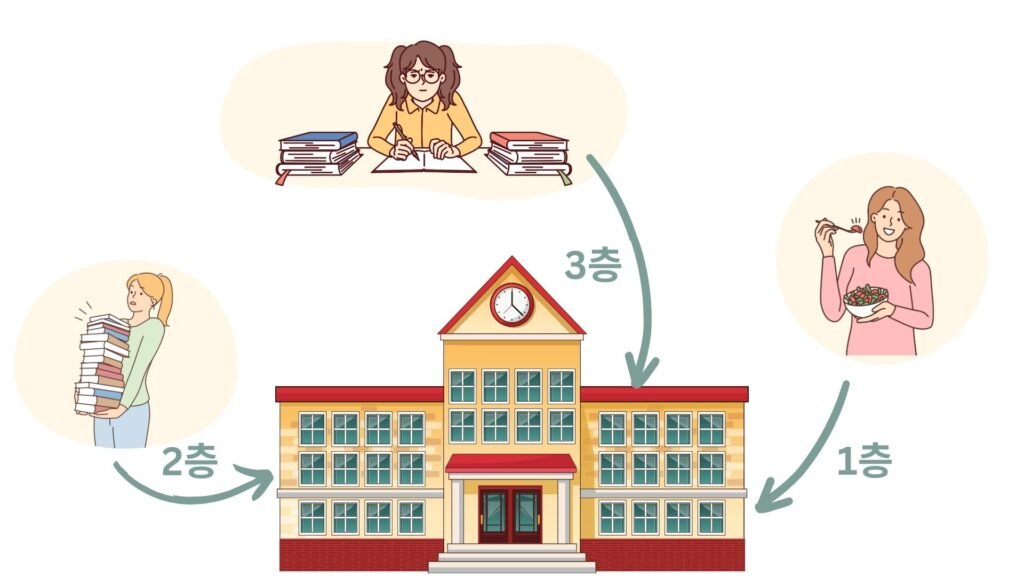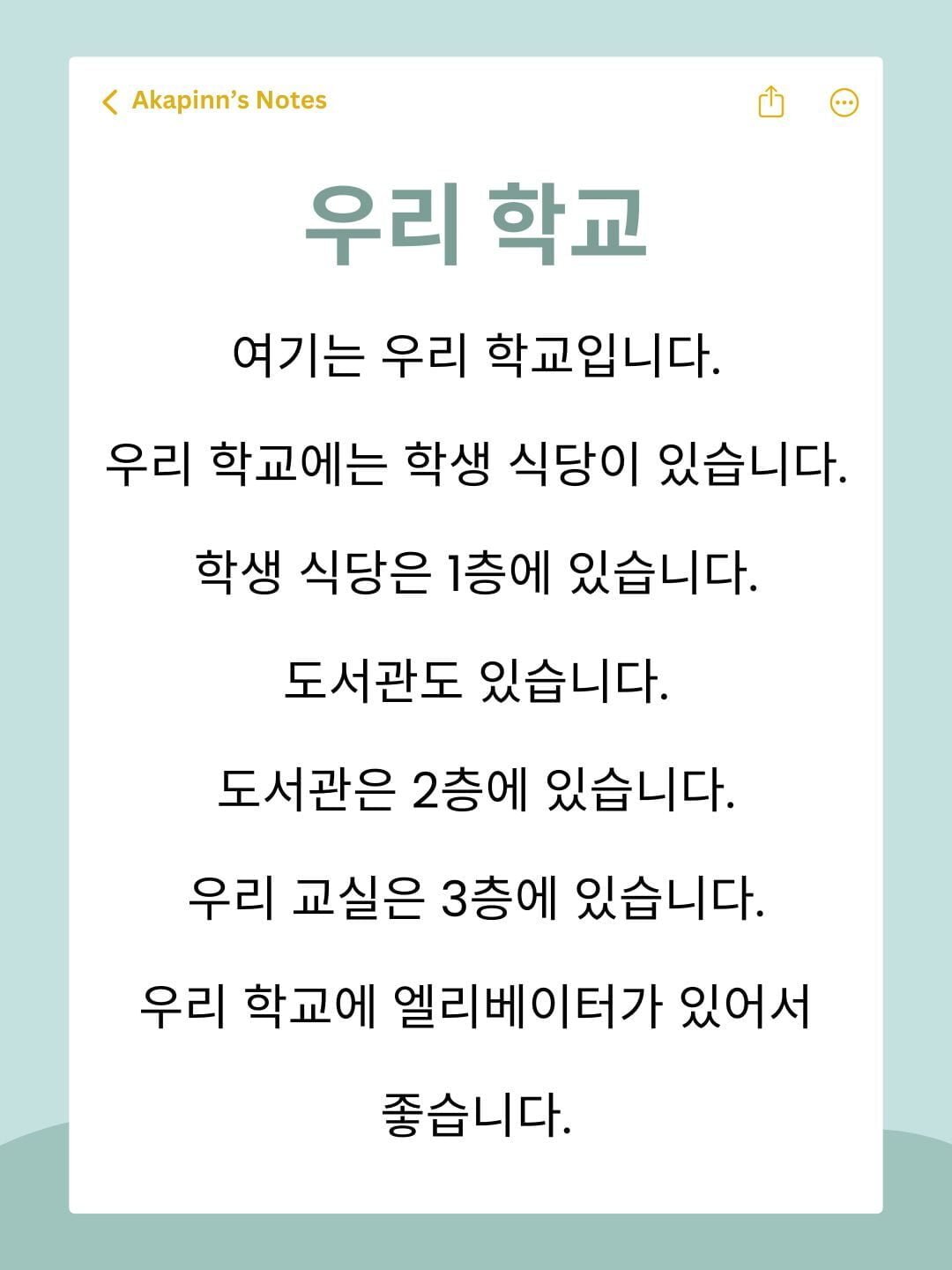안녕하세요 여러분! 🙂 Today we’re tackling a new Korean reading practice for low beginners! It will help you read Korean more comfortably. Reading is my favorite way to study because it’s fun, and we still learn a lot.
If you’re still a beginner looking for something more challenging, check out this text about classmates. It’s a little more complicated. I’m trying to write the difficulty accordingly!
In this article, you will find :
- A short text or story written in Korean
- An audio file
- A translation of the text
- A vocabulary list
- A short explanation of the most difficult grammar parts if necessary
- A few questions to review your understanding of the text
Table of Contents
Korean Reading Practice

우리 학교
여기는 우리 학교입니다.
우리 학교에는 학생 식당이 있습니다.
학생 식당은 1층에 있습니다.
도서관도 있습니다.
도서관은 2층에 있습니다.
우리 교실은 3층에 있습니다.
우리 학교에 엘리베이터가 있어서 좋습니다.

Translation
My School
Here is my school.
There is a student cafetaria in my school.
The student cafetaria is at the first floor.
There is also a library.
The library is at the second floor.
My classroom is at the third floor.
There is an elevator at my school, so that’s nice.

Vocabulary
| 한국어 | 영어 |
|---|---|
| 여기 | Here |
| 학교 | School |
| 학생 식당 | Student cafetaria |
| 층 (1층 [일층], 2층 [이층], 3층 [삼층]) | Floor |
| 도서관 | Library |
| 교실 | Classroom |
| 엘리베이터 | Elevator |
| 좋다 | To be good |
Grammar points
-에
The particle -에 is used to indicate location or direction. It’s often translated as “at,” “in,” “on,” or “to” in English. This particle is essential for indicating where an action occurs or where something is located.
Examples:
학교에 – “at school”
집에 – “at home”
공원에 – “in the park”
-도
The particle -도 indicates that something or someone else is also included in the statement. It’s equivalent to “also,” “too,” or “as well” in English. -도 attaches directly to nouns or pronouns and is placed after the subject or object.
Examples:
저도 – “me too”
우리도 – “us too” or “we also”
(in text) 도서관도 있습니다 – “there is also a library”
-아/어서
-아/어서 is used to express a reason or cause for an action. It’s equivalent to “because” or “since” in English. -아/어서 is attached to the verb stem and is used to connect two clauses, with the first clause explaining the reason for the action in the second clause.
Examples:
바빠서 – “because I’m busy”
맛있어서 – “because it’s delicious”
(in text) 엘리베이터가 있어서 좋습니다. – (lit.) “Because there is an elevator, it’s nice”
Questions : About the Text
(1) Choose the correct answer
① 도서관은 1층에 있습니다
② 도서관은 2층에 있습니다
③ 도서관은 3층에 있습니다
④ 도서관은 없습니다
(2) True or false ?
① 우리 학교에 엘리베이터가 없습니다.
② 우리 교실은 1층에 있습니다.
③ 우리 학교에 학생 식당이 없습니다.
④ 우리 학교에 도서관이 있습니다.
Answers
First question :
② 도서관은 2층에 있습니다
Second question :
① 우리 학교에 엘리베이터가 없습니다. => False
② 우리 교실은 1층에 있습니다. => False
③ 우리 학교에 학생 식당이 없습니다. => False
④ 우리 학교에 도서관이 있습니다. => True
Study Method for Texts
If you’re not familiar with text study, here’s a method I would suggest you try.
To study this text, start by reading it from beginning to end once without paying too much attention to whether you understand fully or not. Then, listen to the audio file (if there is one) and read along.
You can press pause as many times as needed.
During your second read, try to understand as much as possible. If you can’t understand some of the words, check their meaning as well.
When you finish your second read, ensure you understood the story/text correctly. Read a third time (with or without audio). It’s even better if you read it out loud: it will improve your speech fluency over time.
You can then try answering the questions asked at the end!





i saw a reading practice post on pinterest and followed the website here
i wish there were more reading texts like these theyre really helpful!
More will come ! 🙂 We are working on something special for those who like learning through reading. I hope you will like it.
Pinterest brought me here. Your website is sooooo aesthetically pleasing. I also love that you covered the grammar, vocabs and even provided a study method for each reading practice/story, which is very helpful! You’re doing a great job! Thank you!
so good
tnx
thank you so much!